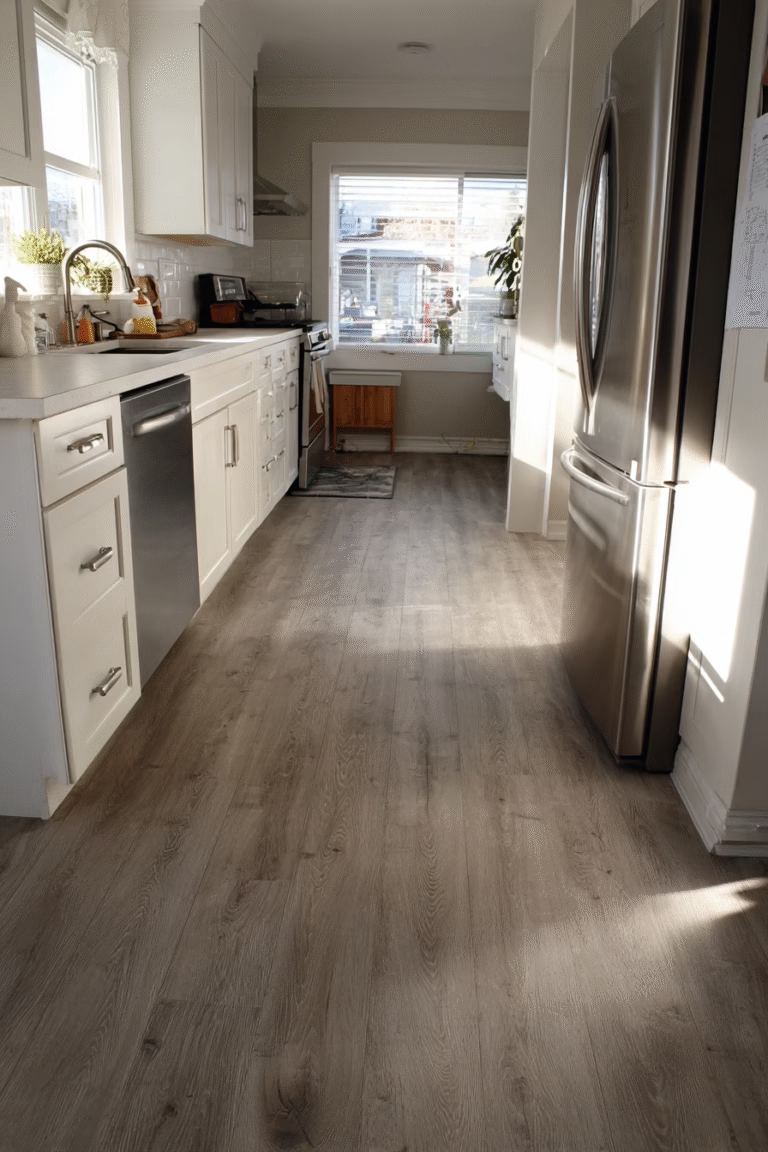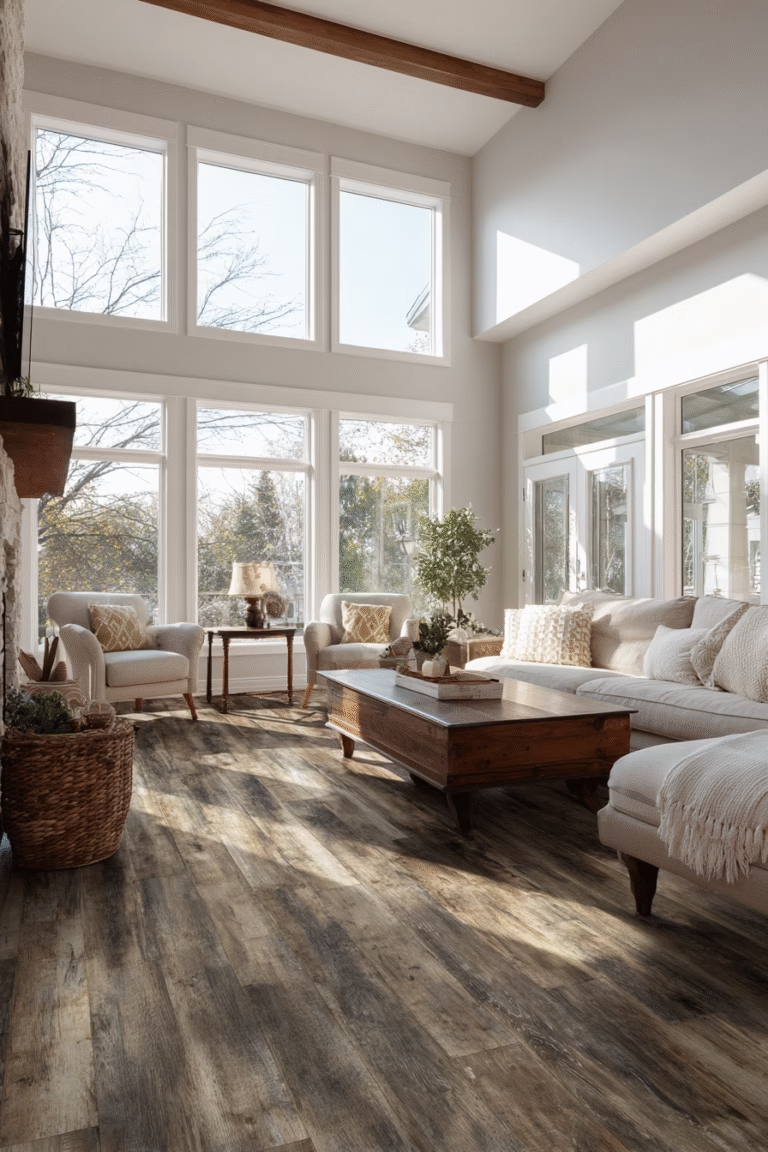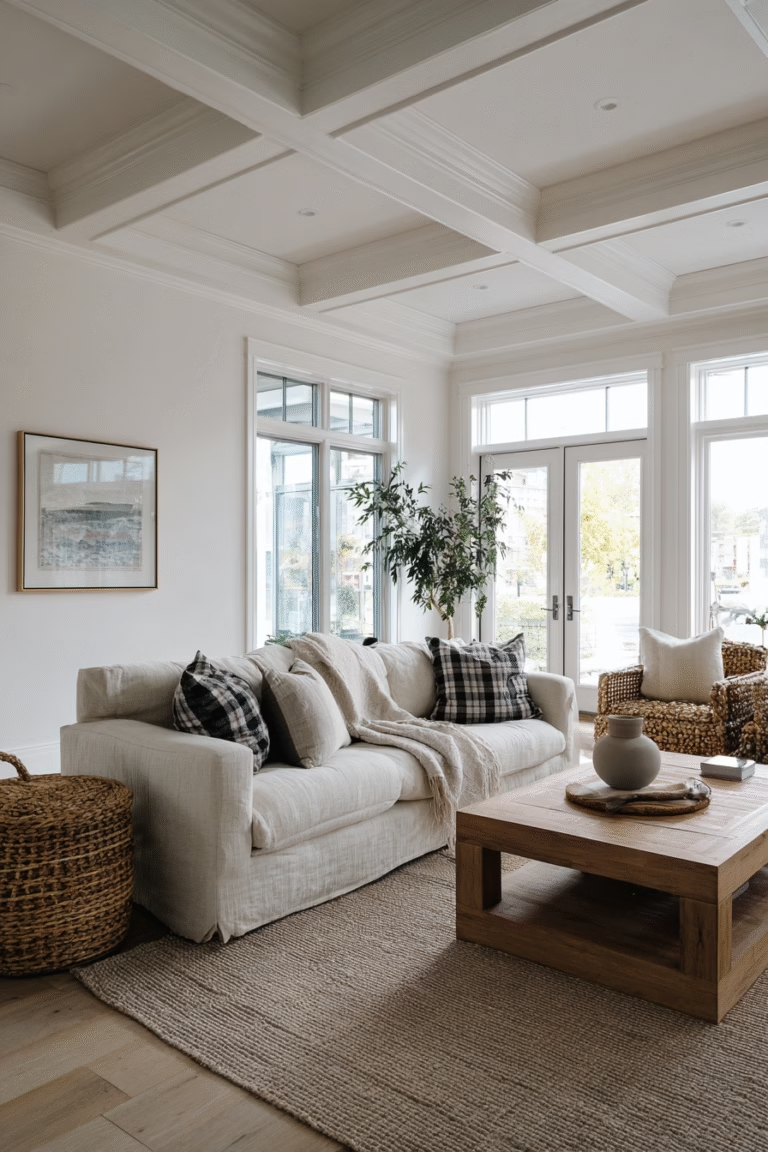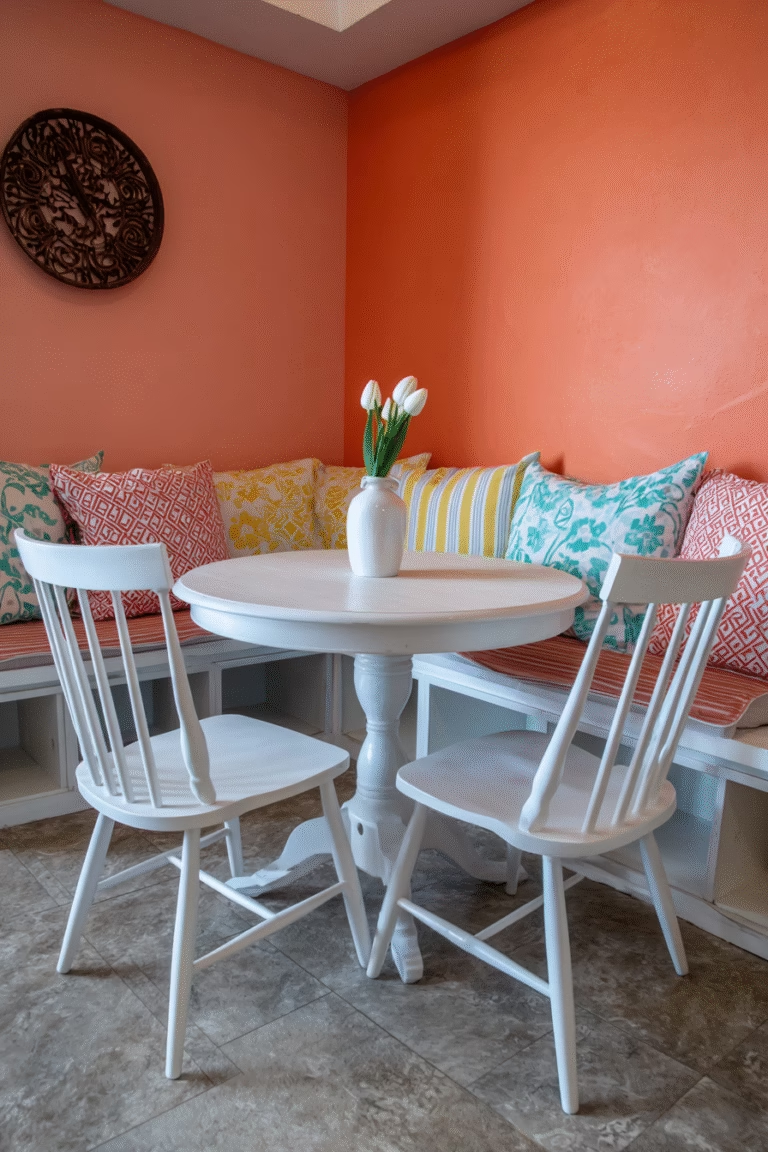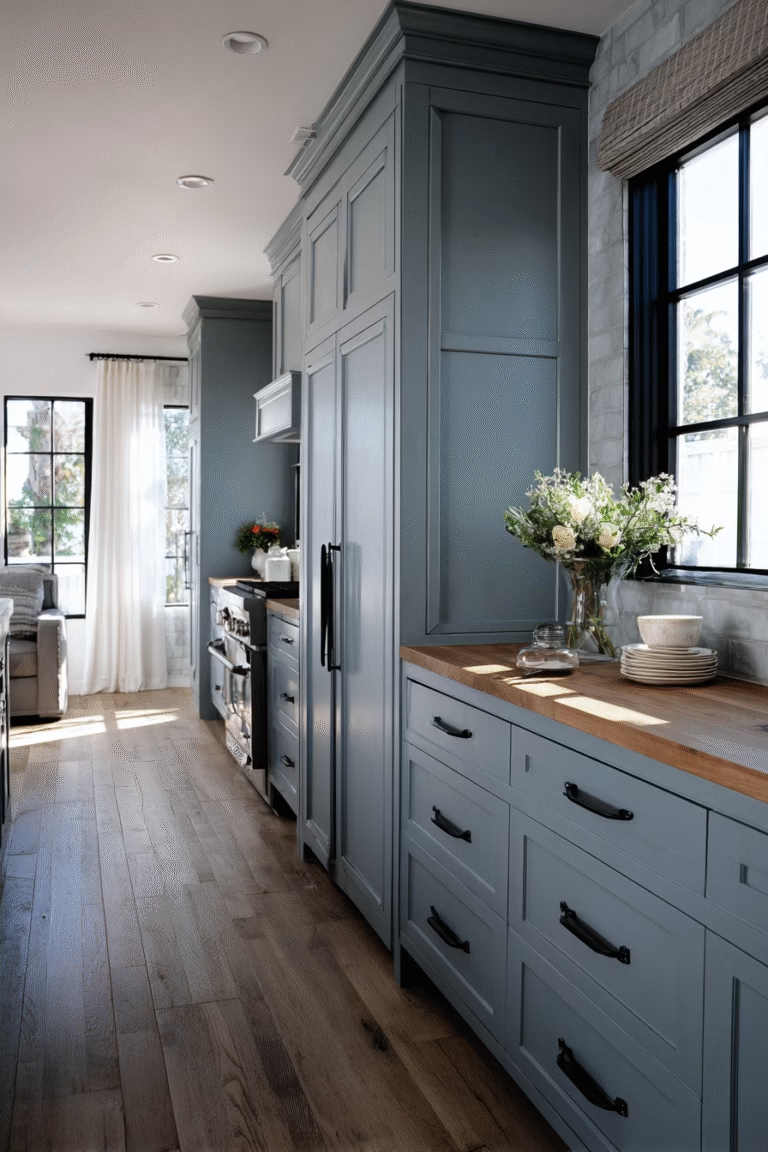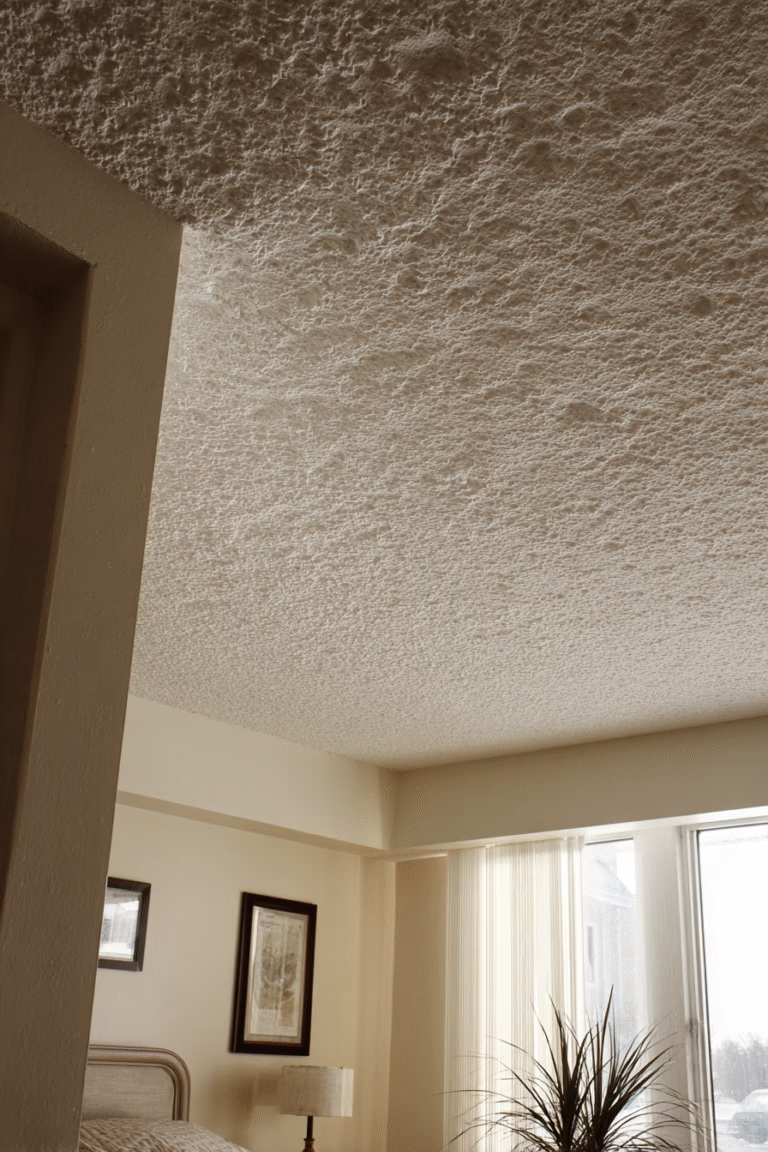17 Tips to Choose the Perfect Ceiling Wallpaper for Any Room
This site contains affiliate links. As an Amazon Associate, I earn from qualifying purchases. The content on this website was created with the help of AI. Please read our Editorial Policy for more information.
Tired of staring at boring white ceilings? You’re not alone. Interior designers are transforming the often-overlooked “fifth wall” into stunning focal points that completely change how a room feels. According to a 2025 trend survey of 643 interior designers by 1st Dibs, 26% voted wallpapered ceilings among their top design choices for the year—and for good reason.
Ceiling wallpaper adds depth, personality, and visual interest in ways that paint simply can’t match. But here’s the challenge: choosing the wrong pattern, color, or scale can make your ceiling feel overwhelming or out of place. The key is understanding how ceiling wallpaper works with your room’s size, natural light, existing colors, and overall design style.
This comprehensive guide walks you through everything you need to know to choose ceiling wallpaper that enhances your space beautifully. From matching patterns to room function to understanding how ceiling height affects your options, you’ll learn the expert principles that interior designers use when selecting wallpaper for the ceiling.
Whether you’re needing wallpaper designs for a bedroom, an elegant dining room, or a playful nursery, these 16 tips and wallpaper ideas will help you make confident decisions that transform your fifth wall into something extraordinary.
Understanding the Fifth Wall Concept and Why It Matters
The ceiling is often called the “fifth wall” in interior design because it’s a surface with just as much potential as your four walls—yet it’s frequently forgotten. Wallpapering your ceiling draws the eye upward, creates visual depth, and can dramatically alter how spacious or intimate a room feels. This design approach is especially powerful in rooms where you spend time looking up, like bedrooms or spaces with architectural features worth highlighting.
When you wallpaper the ceiling, you’re creating an immersive experience that wraps the entire room in design rather than stopping at eye level. This technique works particularly well in rooms with limited wall space due to windows, doors, or built-in features. A kitchen with floor-to-ceiling cabinets, for instance, has little wall real estate for decoration—but the ceiling offers a blank canvas for pattern and color.
The psychological effect of a wallpapered ceiling shouldn’t be underestimated. Darker tones overhead can make a room feel more intimate and cozy, perfect for creating a den-like atmosphere in a home office or library. Lighter patterns with open designs can make ceilings feel higher and rooms more airy. Understanding this fundamental concept helps you approach ceiling wallpaper as a strategic design decision rather than just a decorative afterthought.
1. Match Wallpaper Patterns to Room Function and Activity

The function of your room should guide your wallpaper choice because different spaces serve different purposes. Bedrooms are where you lie down and gaze upward—making them ideal candidates for calming, dreamy ceiling wallpaper like soft clouds, starry skies, or gentle botanical patterns. You’ll see this design daily from a unique vantage point, so choose something that brings you peace rather than stimulation.
Dining rooms benefit from more dramatic ceiling wallpaper because guests naturally look up toward lighting fixtures during meals and conversation. Geometric patterns, metallic damasks, or bold florals create an elegant atmosphere that elevates formal occasions. The ceiling becomes part of the entertainment experience, sparking conversation and adding visual richness to gatherings.
Bathrooms and powder rooms are excellent spaces for adventurous ceiling wallpaper choices because they’re smaller, enclosed areas where bold designs won’t overwhelm. A vibrant tropical pattern or unexpected color on the ceiling can transform a utilitarian bathroom into a luxurious retreat. Just ensure you select wallpaper designed for moisture-prone environments, such as vinyl-coated options that resist humidity and prevent peeling.
Home offices need ceiling wallpaper that inspires focus without causing distraction. Subtle patterns with rhythm—like orderly geometrics or minimal line work—can boost creativity while maintaining a professional atmosphere. Avoid overly busy designs that might pull your attention away from work tasks during video calls or deep concentration periods.
2. Consider Ceiling Height When Selecting Pattern Scale
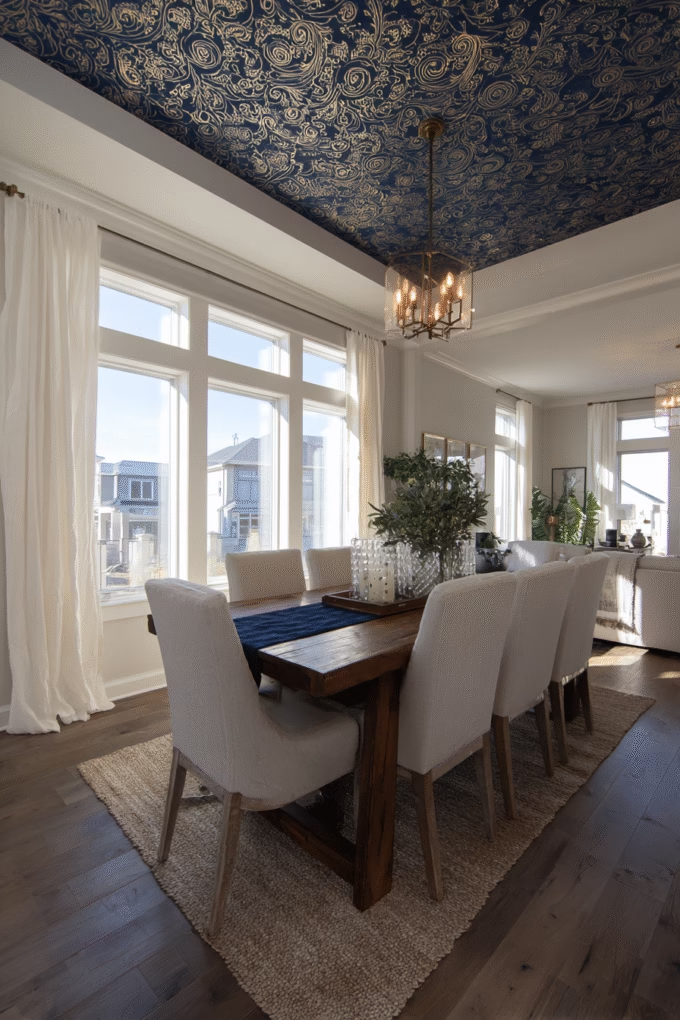
Ceiling height dramatically affects how wallpaper patterns appear and feel in your space. In rooms with standard 8-foot ceilings, large-scale patterns with repeats of 24 inches or more can make the ceiling feel lower and more oppressive. The pattern dominates your field of vision and can create a claustrophobic effect. For standard-height ceilings, choose medium to small-scale patterns with repeats under 12 inches. These patterns add interest without visually lowering the ceiling plane.
High ceilings above 10 feet can absolutely handle large-scale patterns and bold designs. In fact, small patterns on tall ceilings often get lost and appear insignificant from below. Oversized florals, dramatic murals, or large geometric shapes work beautifully in rooms with generous ceiling height because the distance allows you to appreciate the full scope of the design without feeling overwhelmed.
Vaulted or cathedral ceilings present unique opportunities for ceiling wallpaper. The angled planes create natural sections that can be wallpapered while leaving the flat ceiling area painted, or vice versa. This creates architectural definition and draws attention to the unique ceiling structure. When working with sloped ceilings, consider how the pattern will look from different angles in the room, ensuring it remains visually appealing whether viewed from below or from the side.
According to building standards, the recommended ceiling height for residential spaces is 8 feet minimum, though modern homes often feature 9-foot ceilings on main floors. Understanding your specific measurements helps you scale your wallpaper choice appropriately for visual balance.
3. Coordinate Ceiling Wallpaper Colors With Wall Colors
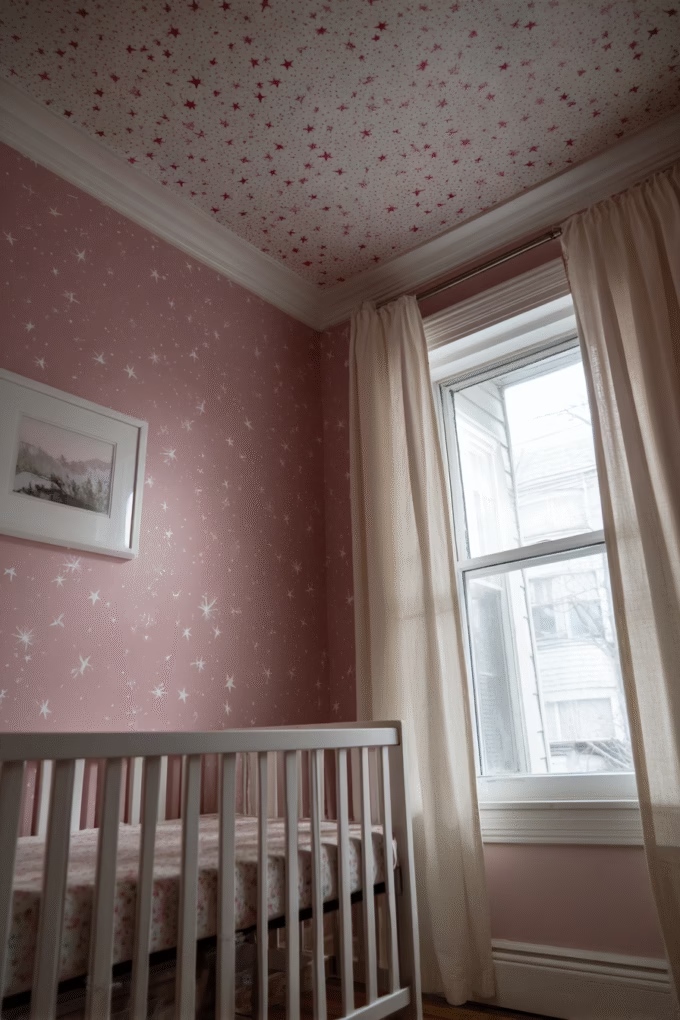
Color coordination between your ceiling and walls is crucial for creating a cohesive design. One effective approach is selecting ceiling wallpaper that incorporates colors already present on your walls. If your walls are painted sage green, for example, choose ceiling wallpaper with green as one of its colors—perhaps a botanical pattern with green leaves on a cream background. This creates visual flow and ties the room together harmoniously.
Contrasting approaches also work beautifully when executed thoughtfully. Pairing neutral walls (white, beige, gray) with a bold, colorful ceiling creates drama and makes the ceiling the room’s star feature. This strategy works particularly well in rooms with minimal wall decoration, allowing the ceiling to provide all the pattern and color interest the space needs.
The 60-30-10 color rule applies to ceiling wallpaper selection: your dominant color should cover 60% of the room (often walls and large furniture), your secondary color 30% (upholstery, curtains), and accent colors 10% (decorative objects, artwork). Your ceiling wallpaper can serve as either the secondary or accent color depending on how bold it is. A vibrant ceiling wallpaper makes a strong accent that ties together other accent colors throughout the room.
Monochromatic ceiling wallpaper—where the pattern uses varying shades of a single color—creates subtle sophistication without introducing additional hues to coordinate. This approach works wonderfully in rooms with already complex color schemes, adding texture and pattern through tone-on-tone design rather than competing colors.
4. Choose Wallpaper Based on Your Interior Design Style
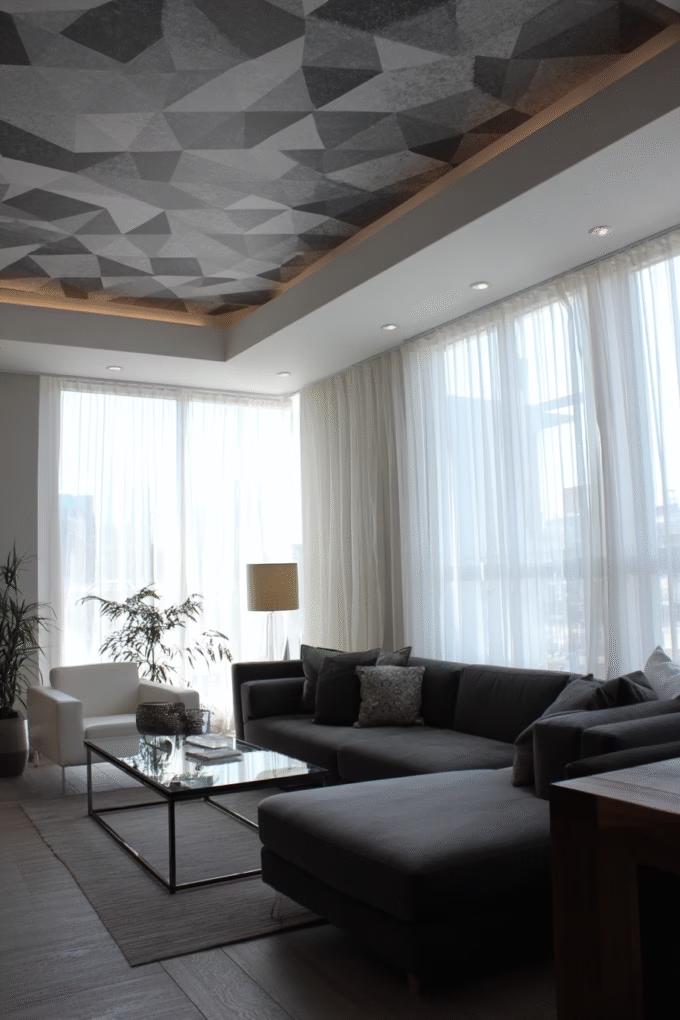
Your home’s overall interior design style should inform your ceiling wallpaper choice to maintain visual consistency. Modern and contemporary interiors benefit from ceiling wallpaper with clean lines, geometric patterns, or abstract designs in neutral or bold monochromatic colorways. Think hexagons, stripes, or minimalist line drawings that complement the sleek furniture and uncluttered aesthetic modern design embodies.
Traditional and classic interiors call for ceiling wallpaper with established patterns like damasks, toile, or formal florals. These timeless designs have historical precedent—ornate ceiling treatments were hallmarks of grand European homes. Metallic accents in gold or silver add period-appropriate elegance. Traditional ceiling wallpaper often features symmetrical patterns and rich colors like burgundy, navy, or forest green that complement wood furniture and formal architectural details.
Farmhouse and cottage styles embrace ceiling wallpaper with natural motifs, gingham checks, or vintage-inspired florals in soft, weathered colorways. Cream, sage, powder blue, and muted coral work beautifully overhead in farmhouse interiors. The pattern should feel slightly worn or hand-painted rather than crisp and perfect, reinforcing the lived-in, collected-over-time aesthetic that defines farmhouse design.
Bohemian and eclectic interiors allow for the most creative freedom with ceiling wallpaper. Mix patterns freely—a Moroccan-inspired geometric ceiling can pair with eclectic wall art and global textiles. Vibrant colors, unexpected combinations, and artisan-made patterns all fit within boho style. The key is ensuring the ceiling wallpaper feels intentionally chosen rather than randomly added.
According to the 2025 interior design trends, maximalism and eclecticism are gaining popularity, with designers embracing bold ceiling treatments as expressions of personal style rather than following minimalist restraint.
5. Understand How Natural Light Affects Wallpaper Appearance

Natural light dramatically changes how ceiling wallpaper looks throughout the day, making it essential to consider your room’s light exposure when selecting patterns and colors. North-facing rooms receive cool, indirect light that can make ceiling wallpaper appear slightly muted and cooler in tone. In these spaces, choose wallpaper with warm undertones—creams, beiges, warm grays, or colors with yellow bases—to counteract the cool light and prevent the room from feeling cold.
South-facing rooms flood with warm, direct sunlight for most of the day. This abundant light can wash out delicate patterns or make very light-colored ceiling wallpaper appear nearly white. In southern exposures, you can confidently choose deeper colors or bolder patterns because the strong light will prevent them from feeling too dark or overwhelming.
East-facing rooms enjoy morning sunlight but become shadowy in the afternoon, while west-facing rooms experience the opposite—dim mornings and bright late-day sun. For these rooms with changing light conditions, select ceiling wallpaper that looks appealing in both bright and low light. Medium-value colors and patterns with contrast perform well in variable lighting.
The quantity of natural light also matters. Rooms with large windows or skylights can handle darker ceiling wallpaper because sufficient light prevents the space from feeling cave-like. Rooms with limited windows need lighter ceiling wallpaper to reflect available light and prevent the ceiling from visually closing in on the space. If adding recessed lighting isn’t an option, strategic wallpaper selection can maximize the light you have.
6. Select Pattern Types That Create Your Desired Atmosphere
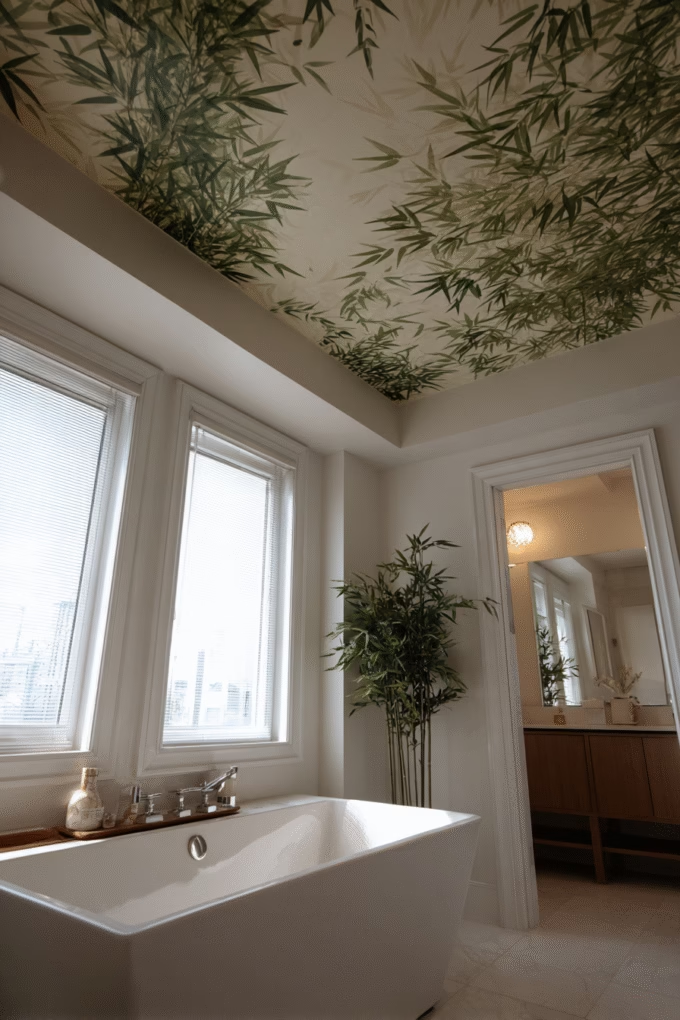
Different pattern types evoke distinct moods and atmospheres, making pattern selection a powerful tool for achieving your design goals. Organic patterns—botanicals, florals, nature scenes—bring the outdoors inside and create calming, biophilic environments. These patterns work particularly well in bedrooms, bathrooms, and spaces where relaxation is the priority. The irregular, flowing nature of organic patterns feels softer and less formal than geometric alternatives.
Geometric patterns—stripes, hexagons, chevrons, lattices—introduce order and structure. They create visual rhythm and can make rooms feel more sophisticated and intentional. Geometric ceiling wallpaper works beautifully in home offices, modern living rooms, and spaces where you want to convey contemporary style. Vertical lines in geometric patterns can even create the illusion of higher ceilings by drawing the eye upward.
Abstract and artistic patterns offer versatility and uniqueness. These designs often combine colors and shapes in non-representational ways, allowing them to complement various decor styles. Abstract ceiling wallpaper can serve as functional art, creating a gallery-like atmosphere without requiring wall space for framed pieces. This approach suits creative personalities and eclectic interiors.
Scenic murals and trompe-l’oeil designs create immersive experiences by depicting specific scenes or architectural features. A cloud-filled sky mural makes ceilings disappear visually, creating the illusion of open air above. Faux coffered ceilings or painted architectural details add dimension to flat surfaces. These dramatic choices work best in larger rooms with higher ceilings where the full scene can be appreciated.
7. Account for Existing Architectural Features

Your ceiling’s architectural features should guide wallpaper selection and application strategy. Crown molding creates a natural frame around ceiling wallpaper, defining where the pattern begins and adding sophisticated detail. The molding acts as a transition between wall color and ceiling pattern, making even bold wallpaper choices feel intentional and finished. If your room has crown molding, use it to your advantage by selecting wallpaper that complements the molding’s formality and scale.
Coffered ceilings with recessed panels offer exciting wallpaper opportunities. You can wallpaper just the recessed panels while painting the beams, creating a striking checkerboard effect that highlights the architectural detail. Alternatively, wallpaper the entire ceiling including beams for a fully immersive look. The three-dimensional nature of coffered ceilings adds shadow and depth that makes patterned wallpaper even more dynamic.
Exposed beams require special consideration. In farmhouse or rustic interiors, wallpaper between beams while leaving the wood exposed creates beautiful contrast. The beams provide natural division lines for the wallpaper, and the combination of natural wood and pattern adds layers of texture and interest. Ensure your wallpaper choice complements the wood tone—warm wallpaper colors pair with honey-toned woods, while cooler wallpaper works with gray-washed beams.
Sloped or cathedral ceilings create unique challenges and opportunities. The angled surface changes how patterns appear from different viewing angles. Consider wallpapering just the flat ceiling portion while painting the slopes, or vice versa, to create architectural definition. When wallpapering sloped areas, choose patterns without a clear directional orientation so they look correct regardless of the viewing angle.
8. Decide Between Peel-and-Stick and Traditional Wallpaper

The type of wallpaper you choose affects both installation difficulty and longevity, making this an important practical consideration. Peel-and-stick wallpaper (also called removable or temporary wallpaper) features a self-adhesive backing that applies directly to the ceiling without paste. This option is ideal for renters, DIY enthusiasts, or anyone who wants flexibility to change designs in the future. Ceiling application is more manageable with peel-and-stick because you can reposition pieces during installation.
The main advantage of removable wallpaper on ceilings is simple removal when you’re ready for a change. It peels away cleanly without damaging the surface underneath, making it perfect for experimenting with ceiling treatments. However, peel-and-stick wallpaper has a shorter lifespan—typically 3-5 years versus 15+ years for traditional wallpaper. It also offers a more limited pattern selection compared to traditional options.
Traditional wallpaper requires paste application and more installation skill, particularly on ceilings where gravity works against you. The paste-the-wall method (applying paste directly to the ceiling rather than the wallpaper) simplifies the process somewhat. Traditional wallpaper provides superior durability, better pattern selection, and often higher-quality printing and materials. For permanent installations in high-end spaces, traditional wallpaper delivers better long-term results.
Pre-pasted wallpaper offers a middle ground—the paste is already on the backing and activates with water. This type is easier to use than unpasted traditional wallpaper but still provides good durability. For ceiling applications, pre-pasted paper works well for experienced DIYers who want quality results without the complexity of mixing and applying paste.
According to Bob Vila’s ceiling wallpaper guide, removable wallpaper goes up and comes off most easily, making it the most forgiving option for first-time ceiling wallpaper installers.
9. Match Wallpaper Intensity to Room Size

Room size significantly affects how wallpaper patterns are perceived, requiring different approaches for small versus large spaces. Small rooms and compact spaces like powder rooms, hallways, or closets can handle surprisingly bold ceiling wallpaper. The limited square footage means even a vibrant pattern won’t overwhelm because you see less of it at once. A small powder room with a dramatic floral ceiling becomes a jewel-box space that delights visitors precisely because of its intimacy and boldness.
In small rooms, ceiling wallpaper actually serves a strategic purpose beyond decoration. It distracts from the room’s limited size by drawing the eye upward and creating a focal point that doesn’t compete with the minimal floor space. Rather than trying to make a small room appear larger with light colors (which can feel bland), embrace its coziness with a statement ceiling that makes the space feel intentionally intimate and special.
Large, expansive rooms require more careful consideration with ceiling wallpaper. A delicate, small-scale pattern on a vast ceiling can appear insignificant and get lost in the space. Large rooms need either bigger pattern scales or murals that can hold their own across significant square footage. A living room with 400+ square feet of ceiling space needs a pattern substantial enough to read as intentional rather than sparse.
In large rooms, you might also consider wallpapering only a portion of the ceiling to create zoning. Wallpaper a tray ceiling insert while leaving the main ceiling painted, or wallpaper the ceiling over a specific area like a dining zone in an open-concept space. This approach adds pattern without requiring wallpaper across an enormous area, which could feel overwhelming and become costly.
10. Consider Wallpaper Texture and Material

Wallpaper texture and material affect both visual appeal and practical performance on ceilings. Smooth, vinyl-coated wallpaper reflects light evenly and creates a clean, modern appearance. This type works well in contemporary spaces and high-moisture areas like bathrooms because the vinyl coating resists humidity and prevents water damage. The smooth surface also makes any pattern appear crisp and sharp, ideal for geometric or photographic designs.
Grasscloth and natural fiber wallpapers add organic texture that creates depth and interest through material rather than pattern. These textured wallpapers absorb light instead of reflecting it, creating a matte, sophisticated finish overhead. Grasscloth ceilings work beautifully in coastal, organic modern, or tropical-inspired interiors where natural materials are central to the design aesthetic. However, grasscloth is more challenging to install on ceilings and shows seams more readily than smooth papers.
Metallic and foil wallpapers reflect light dramatically, making them ideal for adding glamour to dining rooms or creating sparkle in entertainment spaces. These reflective surfaces catch and bounce available light, making rooms feel brighter. Be cautious with metallic ceiling wallpaper in rooms with lots of direct sunlight—the reflection can become almost blinding at certain times of day. Use metallics strategically in spaces with controlled lighting for the best effect.
Embossed and textured vinyl wallpapers create three-dimensional patterns you can feel. These papers are particularly effective at disguising minor ceiling imperfections because the texture camouflages small flaws. The dimensional quality adds visual interest from any angle and creates subtle shadow play as light moves across the surface throughout the day. Embossed papers work well in traditional and transitional interiors where added dimension enhances the formal atmosphere.
Fabric-backed wallpapers offer superior durability and easier installation because they’re less likely to tear during hanging. On ceilings where gravity makes installation challenging, the fabric backing provides extra strength and forgiveness. These premium wallpapers typically come with higher price points but deliver professional results and long-term performance.
11. Plan Around Lighting Fixtures and Features

Ceiling lighting fixtures require careful planning when installing wallpaper because they create practical and visual considerations. Before selecting wallpaper, map out your existing light fixtures, ceiling fans, vents, and any other ceiling penetrations. Choose wallpaper patterns where the repeat allows you to center design elements attractively around fixtures rather than having a light fixture cut awkwardly through a major pattern element.
Recessed lighting creates minimal disruption to ceiling wallpaper compared to pendant fixtures or chandeliers. The small cutouts blend into most patterns without drawing attention. However, if you have numerous recessed lights creating a grid pattern across your ceiling, consider how this layout interacts with your wallpaper choice. Geometric wallpapers with their own grid patterns might compete visually with recessed lighting layouts.
Statement chandeliers and pendant lights become even more dramatic against wallpapered ceilings. The patterned background highlights the fixture as a sculptural element and creates beautiful contrast. In dining rooms, a crystal chandelier against a richly patterned ceiling creates luxury and elegance that plain white ceilings cannot achieve. Consider the visual weight balance—a delicate light fixture might get lost against a very busy ceiling pattern.
Directional lighting from wall sconces or track lighting can create dramatic effects on textured ceiling wallpaper, casting shadows that emphasize the three-dimensional quality of embossed or grasscloth papers. Plan how your lighting will interact with your wallpaper choice—will it create appealing shadow play or awkward highlighting of seams and imperfections?
According to the U.S. Department of Energy, proper lighting placement significantly impacts energy efficiency and ambiance, making coordinated planning between wallpaper and lighting essential for functional, beautiful spaces.
12. Evaluate Wallpaper Durability for Ceiling Applications
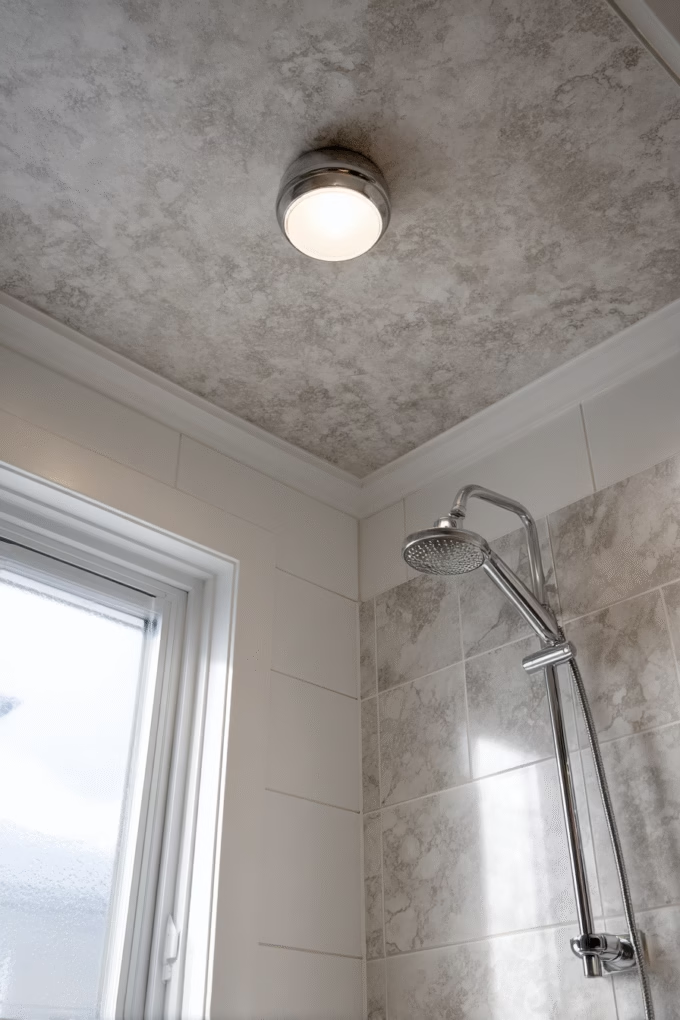
Ceilings experience different wear patterns than walls, requiring specific durability considerations when selecting wallpaper. Unlike walls that face scuff marks, bumps from furniture, and hand oils, ceilings primarily deal with environmental factors like temperature fluctuations, humidity, and exposure to light. Choose wallpaper specifically rated for good light fastness to prevent fading from sun exposure through skylights or large windows.
In moisture-prone rooms like bathrooms and kitchens, ceiling wallpaper must resist humidity and temperature changes. Vinyl-coated or solid vinyl wallpapers perform best in these conditions because they’re washable and moisture-resistant. Paper-based wallpapers can bubble, peel, or develop mold in humid environments, making them unsuitable for bathroom ceilings regardless of how attractive the pattern may be.
The weight of wallpaper matters significantly for ceiling applications. Heavyweight wallpapers require stronger adhesive and more installation expertise because gravity pulls constantly during and after installation. Lightweight to medium-weight wallpapers install more easily on ceilings and are less likely to sag or peel over time. When shopping, check the wallpaper’s weight specification—papers under 200 grams per square meter work well for DIY ceiling installations.
Pre-existing ceiling texture affects wallpaper durability. Smooth, well-prepared ceilings provide the best surface for wallpaper adhesion. Popcorn or heavily textured ceilings require removal or smoothing before wallpaper application because the texture prevents proper adhesion and creates air pockets where the paper can bubble or peel. Properly preparing your ceiling surface before wallpaper installation is crucial for long-term durability.
According to Houzz’s ceiling wallpaper guidelines, problems with ceiling structure should be addressed before wallpaper installation, as wallpaper can only disguise minor cosmetic imperfections, not structural issues.
13. Understand Cost Implications and Budget Accordingly

Ceiling wallpaper costs vary dramatically based on material type, installation method, and the help you’ll need with application. Basic peel-and-stick wallpaper ranges from $30-80 per roll, with each roll typically covering 28-30 square feet. Traditional wallpaper costs $50-150 per roll for quality options, while designer papers and specialty materials like grasscloth can exceed $200-400 per roll. Calculate your ceiling square footage carefully to estimate material costs accurately.
Installation costs add significantly to the total expense. Professional wallpaper installation runs $3-7 per square foot, with ceiling installation commanding higher rates than wall application due to the technical difficulty. A 12×15 foot bedroom ceiling (180 square feet) professionally wallpapered would cost $540-1,260 in labor alone, plus materials. DIY installation saves labor costs but requires specific tools (scaffolding or tall ladders, wallpaper smoothers, utility knives) and patience for the challenging overhead work.
Hidden costs to consider include ceiling preparation, which may require filling holes, sanding, and priming to create a smooth surface. If your ceiling has popcorn texture, removal costs $1-3 per square foot before wallpaper can be applied. Additional expenses might include crown molding installation (if you want to frame your wallpapered ceiling), upgraded adhesives for heavyweight papers, or renting specialized equipment for high ceilings.
Budget strategically by wallpapering smaller spaces first. A powder room ceiling might only require one roll of wallpaper and can be DIY-installed over a weekend, allowing you to experiment with ceiling wallpaper without major financial commitment. Save large, complex ceilings for professional installation or for after you’ve gained experience with easier applications.
Prices continue to trend upward in the wallpaper market, with premium options becoming even more expensive. Setting a realistic budget that accounts for both materials and skilled labor ensures your ceiling wallpaper project succeeds without financial stress.
14. Create Balance Between Walls and Ceiling
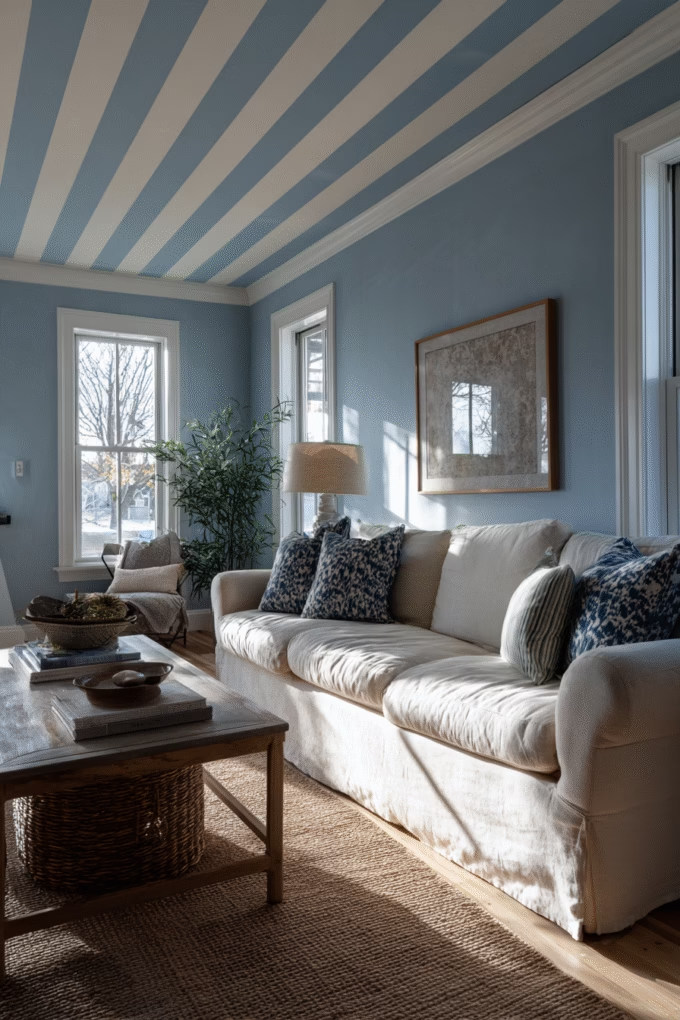
Achieving visual balance between wallpapered ceilings and your walls requires thoughtful coordination to prevent the room from feeling overwhelming or chaotic. One reliable approach is the contrast method: if your ceiling has bold, patterned wallpaper, keep your walls simple with solid paint colors or very subtle textures. This allows the ceiling to be the statement while walls provide visual rest. The eye needs somewhere to land without pattern, and blank walls serve this purpose beautifully.
The continuation approach creates an immersive, enveloping effect by extending wallpaper from walls onto the ceiling, particularly effective in rooms with sloped or vaulted ceilings. This technique works best with medium-scale patterns that aren’t too busy—you’re covering significant square footage, so overwhelming patterns become exhausting. Continuation works beautifully with stripes, which naturally flow from walls to ceiling, or with trellis patterns that create repeating geometric interest without visual chaos.
The coordinated approach uses different but complementary patterns on walls and ceiling—perhaps a geometric ceiling with floral walls, unified by a shared color palette. This sophisticated technique requires an educated eye for pattern mixing. The patterns should be different scales (one large, one small) and different styles (one geometric, one organic) while sharing at least two colors. This creates cohesion through color while adding complexity through pattern variety.
The architectural emphasis approach uses ceiling wallpaper to highlight specific architectural features. Wallpaper a tray ceiling insert while painting the ceiling field and walls, or wallpaper the ceiling in a bay window alcove while keeping the main room ceiling painted. This zoning technique adds interest to special architectural elements without overwhelming the entire room.
According to interior design principles, the balance between ceiling and wall treatments should enhance room proportions rather than upset them, with careful attention to scale and visual weight.
15. Think About Long-Term Commitment and Changeability
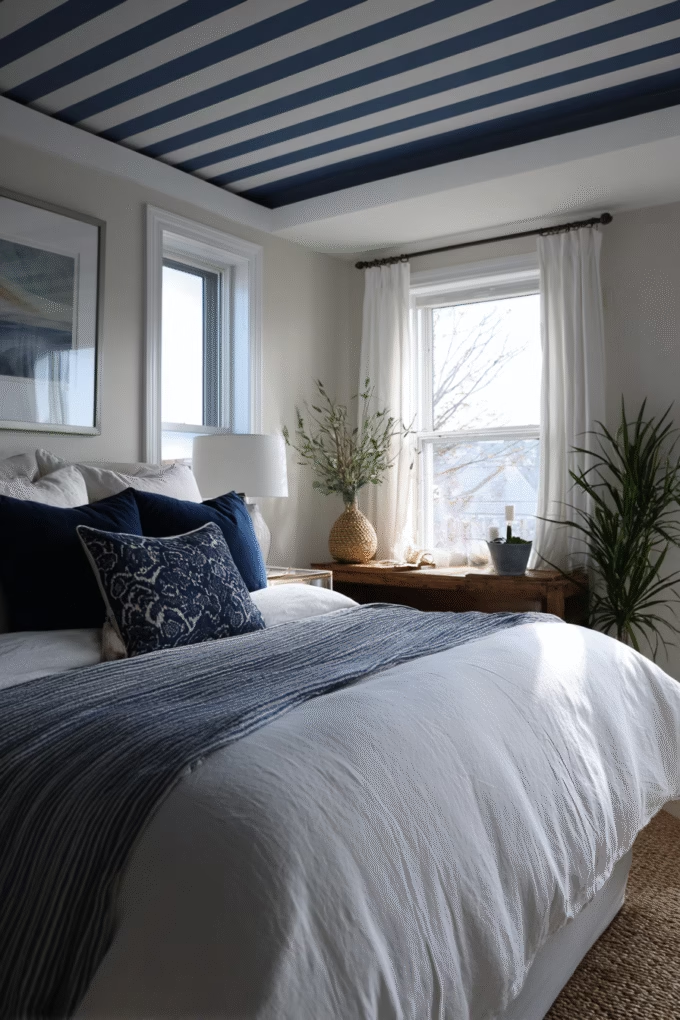
Ceiling wallpaper represents a more significant commitment than wall treatments because it’s harder to access for changes and more labor-intensive to remove. Before selecting a pattern, honestly assess your design constancy—will you still love this choice in 5-10 years? Trendy patterns that feel exciting now might appear dated quickly, while classic designs tend to age gracefully. If you’re drawn to bold, trending patterns, consider using them in small spaces like powder rooms where future changes are more manageable.
Timeless patterns that transcend trends include classic stripes, subtle geometrics, traditional damasks, and natural textures like grasscloth or linen looks. These designs have proven staying power across decades and adapt well to evolving decor around them. You can update furniture, artwork, and accessories while your ceiling wallpaper remains relevant and attractive.
For renters or commitment-phobic decorators, peel-and-stick wallpaper offers the perfect solution for ceiling applications. The removable nature means you can experiment with statement ceilings without permanent consequences. When you move or tire of the look, the wallpaper peels away cleanly, allowing for easy changes. This flexibility makes ceiling wallpaper accessible to people who previously avoided it due to permanence concerns.
Consider how your ceiling wallpaper will coordinate with potential future changes to other room elements. Will it work with different wall colors if you repaint? Can it adapt to various furniture styles? Neutral-based patterns with classic design elements offer more flexibility for future decorating changes than highly specific, colorful, or ultra-trendy designs.
The average wallpaper lifespan is 15 years for traditional types, though you may want to update sooner for style reasons. Factor replacement considerations and costs into your initial decision-making to avoid future regret.
16. Test Before Committing to Full Installation
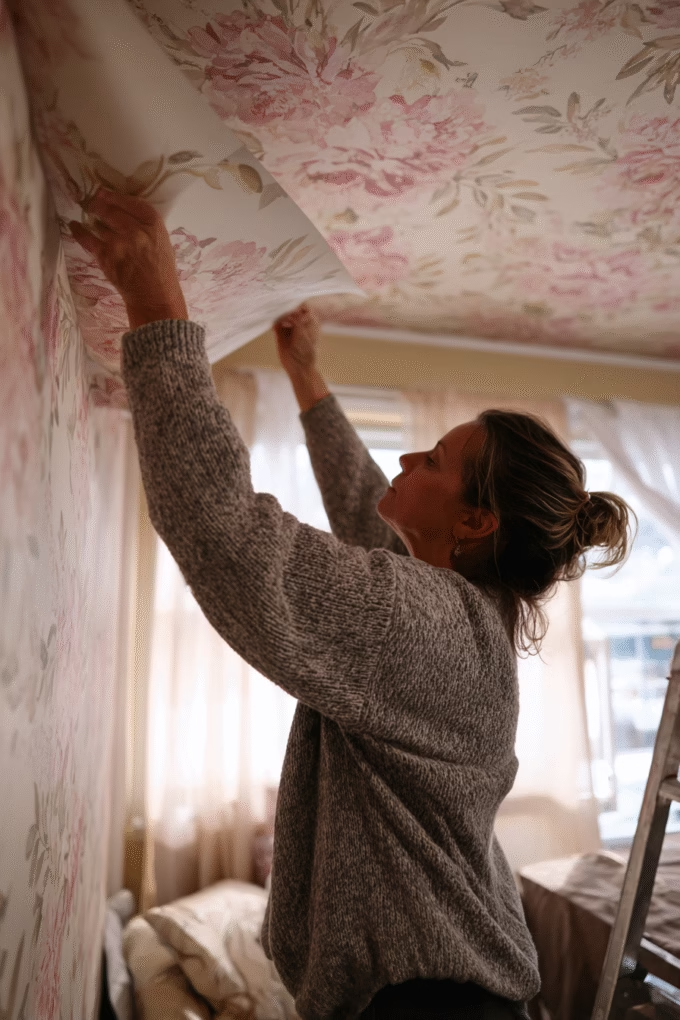
Before committing to ceiling wallpaper across your entire space, smart designers recommend testing your choice to ensure it achieves your desired effect. Order samples of your top wallpaper choices—most companies offer 12×12 inch or larger sample sheets for $5-15 each. Hold these samples up against your ceiling in different lighting conditions throughout the day. What looks beautiful in morning light might appear completely different in afternoon or evening illumination.
Create a large-scale mockup if possible by purchasing a single roll and installing it on a poster board or foam core board cut to ceiling dimensions. Prop this mockup horizontally at ceiling height to see exactly how the pattern will look overhead from your normal viewing angles. This is especially important for ceiling applications because you view ceilings from below at a distance—patterns appear different than when you see wallpaper samples at eye level.
Consider the viewing distance factor unique to ceilings. You typically view ceilings from 8-12 feet away, meaning fine details might disappear while overall color and large pattern elements dominate. A wallpaper with beautiful intricate detailing you love in the sample book might read as a solid color from below if the details are too small to register at viewing distance.
Test your wallpaper choice with your existing room elements before purchasing enough rolls for full installation. Place the sample next to your wall paint color, flooring, and major furniture pieces. Do the colors coordinate or clash? Does the pattern scale feel right next to your existing patterns in rugs, upholstery, or curtains? Testing reveals potential issues before you invest hundreds of dollars in wallpaper and labor.
Professional designers routinely use this testing approach before specifying wallpaper for clients. Living with samples for several days reveals things you might miss in a quick showroom decision—how the pattern makes you feel, whether it creates the atmosphere you intended, and if it truly fits your space. This small investment in samples prevents costly mistakes in full installations.
Frequently Asked Questions About Ceiling Wallpaper
Does Removing Wallpaper Damage Walls?
Removing wallpaper can potentially damage walls, but the extent depends on several factors. Peel-and-stick wallpaper generally won’t damage walls when removed properly, though it may pull off small patches of paint, especially if the paint has a flat or matte finish.
Traditional wallpaper is more likely to cause damage during removal. If the wall wasn’t properly primed before wallpaper installation, removing wallpaper can tear off the outer paper layer of drywall. According to professional painting contractors, it’s very difficult to avoid some drywall damage with any removal method.
To minimize damage when removing wallpaper, pull slowly and gently at a 90-degree angle. Using heat from a hairdryer can soften the adhesive and make removal easier. After wallpaper removal, walls typically need to be sealed with an oil-based primer before repairs to prevent the remaining glue from reactivating when you apply drywall compound.
Does Wallpaper Ruin Your Walls?
Wallpaper itself doesn’t ruin walls when properly installed and maintained. The potential for wall damage primarily occurs during removal or if the wallpaper wasn’t installed correctly in the first place.
High-quality peel-and-stick wallpaper with removable adhesive is designed specifically to avoid wall damage. When applied and removed correctly, it pulls away without damaging the underlying walls. However, walls with heavily textured surfaces, flaky plaster, or poor paint conditions are more susceptible to damage.
Traditional wallpaper can actually protect walls in high-traffic areas because it’s more durable than paint and resists scuffs and scratches. The key to preventing wall damage is proper surface preparation before installation and careful removal techniques when it’s time for a change.
How Long Does Wallpaper Last on Walls?
Wallpaper longevity varies significantly based on quality and type. High-quality traditional wallpaper can last 15 years or more when properly installed, and in some cases, well-maintained wallpaper in historic homes has lasted for decades.
According to the Wallcovering Installers Association, vinyl wallcoverings can last up to five times as long as paint under typical usage conditions—often 15 years or more while maintaining their original appearance. Traditional wallpaper generally lasts at least three times longer than paint.
Peel-and-stick wallpaper has a shorter lifespan of 3-7 years depending on quality, installation, and environmental conditions. Budget peel-and-stick options may only last 1-3 years, while higher-quality removable wallpaper with better adhesive can last 5-7 years or longer.
Factors affecting wallpaper lifespan include humidity levels, direct sunlight exposure, wall preparation quality, and whether the wallpaper is in a high-traffic area.
What Does Striped Wallpaper Do to a Room?
Striped wallpaper creates powerful visual effects that can dramatically alter how a room feels. The primary benefit is its ability to manipulate perceived room dimensions.
Vertical stripes draw the eye upward, creating the illusion of higher ceilings and making rooms appear taller. This makes vertical striped wallpaper particularly effective in spaces with standard 8-foot ceilings or rooms where you want to add a sense of height.
Horizontal stripes have the opposite effect—they make rooms appear wider and more expansive. According to wallpaper design experts, horizontal stripes are typically used in living rooms, waiting areas, and parlors where creating a sense of width is desirable.
Striped wallpaper also adds structure and rhythm to a space. It can serve as either a bold statement or a neutral backdrop depending on the stripe width, color contrast, and pattern complexity. Thin stripes create a busier, more detailed appearance, while wide stripes make a bolder, calmer statement. The classic nature of stripes means they work well with virtually any design style and can be successfully mixed with other patterns like florals or geometrics.
Is Ceiling Wallpaper a Good Idea?
Ceiling wallpaper can be an excellent design choice when used appropriately, though it’s not suitable for every space. According to interior design experts, wallpapered ceilings add character, improve room proportions, and bring pattern to challenging spaces.
Ceiling wallpaper works best when:
- The room has limited wall space for decoration (kitchens with extensive cabinetry, rooms with many windows)
- You want to create an intimate, cozy atmosphere with darker patterns
- The space has interesting architectural features like coffered ceilings or crown molding
- You’re decorating smaller rooms like powder rooms, dining rooms, or home offices where the dramatic effect won’t overwhelm
- The ceiling is smooth and properly prepared
Ceiling wallpaper may not be ideal if:
- You have popcorn or heavily textured ceilings that won’t provide proper adhesion
- The space is an open-concept area where ceiling pattern could feel overwhelming
- Ceiling height is very low (under 8 feet) and dark patterns might make it feel oppressive
- You’re planning to sell your home soon, as bold ceiling treatments may not appeal to all buyers
The 2025 design trend survey showing 26% of professional designers favoring wallpapered ceilings indicates this treatment has moved from unusual to mainstream. When executed thoughtfully with appropriate pattern selection and professional installation, ceiling wallpaper transforms the often-neglected fifth wall into a stunning design feature that elevates your entire space.
Turn Your Fifth Wall into a Masterpiece
Choosing the right wallpaper for your ceiling transforms an overlooked surface into a defining design element that elevates your entire room. By considering room function, ceiling height, color coordination, design style, and practical factors like lighting and durability, you’ll make confident selections that enhance your space beautifully. Remember that your ceiling wallpaper should serve your lifestyle—choose patterns and colors that make you happy every time you look up.
The rising popularity of ceiling wallpaper reflects a broader design shift toward maximizing every surface’s potential in our homes. Your fifth wall offers square footage that’s currently going to waste if it’s just painted white. Whether you opt for subtle texture that adds depth without drama, or bold patterns that become the room’s focal point, ceiling wallpaper allows you to express your personal style in unexpected ways and these ceiling wallpaper ideas are sure to help inspire the wallpaper you choose.
Start small if you’re new to ceiling wallpaper—a powder room or small bedroom lets you experiment with this dramatic design technique without overwhelming commitment. As you gain confidence, you might find yourself wallpapering ceilings throughout your home, creating cohesive design stories that extend beyond the traditional four walls. Your ceilings are waiting to become extraordinary, and with the right wallpaper choices, they absolutely will.
